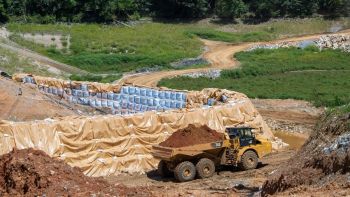Design and Construction of a Reservoir

|
| The Lake Williams Dam, a reservoir which serves the city of York, Pennsylvania, is reconstructed and rehabilitated to meet modern standards. (York Daily Record) |
“Reservoir operating goals vary with the storage in the reservoir. The highest zone in the reservoir is that space reserved at any particular time for the control of floods. This zone includes the operational flood control space and the surcharge space required for the passage of spillway flows. Whenever water is in this zone it must be released in accordance with flood-control requirements. The remaining space can be designated as conservation space. The top zone of conservation space may include storage that is not required to satisfy the firm conservation demands, including recreational use of the reservoir. Water in this space can be released as surplus to serve needs or uses that exceed basic requirements. The middle zone of conservation space is that needed to store water to supply firm water needs. The bottom zone of conservation space can be termed buffer space, and when operation is in this zone the firm services are curtailed in order to prevent a more severe shortage later. The bottom zone of space in the reservoir is designated as the minimum pool reserved for recreation, fish, minimum power head, sediment reserve, and other storage functions”.[1]
Examples
![]()
Best Practices Resources
![]() EM 1110-2-1420 Hydrologic Engineering Requirements for Reservoirs
EM 1110-2-1420 Hydrologic Engineering Requirements for Reservoirs
Trainings
![]()
Citations:
Revision ID: 2694
Revision Date: 09/09/2022
